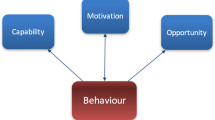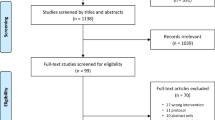Abstract
With decreasing inpatient rehabilitation lengths of stay, there may be a greater risk of spinal cord injury (SCI) populations being discharged into the community without the self-management skills needed to prevent secondary complications. Recent advancements in mobile health has made mobile apps a feasible method of delivering population-based, self-management interventions to address SCI-specific secondary complications. The objective of this study is to describe stakeholder perspectives on the development of a functional mobile app to facilitate self-management skills needed to prevent secondary complications following recent SCI during inpatient rehabilitation. A user-centered design approach was used that involved an evolving mobile app and the collection of prospective qualitative data. Stakeholders from three groups were enrolled in the study: individuals admitted for rehabilitation following SCI (n = 20) and informal (n = 7) and formal (n = 48) caregivers. Iterative feedback was gathered from rehabilitation inpatients during ongoing interactions and via post-discharge exit questionnaires, from informal caregivers via one-on-one interviews, and from formal caregivers via series of focus groups at various phases throughout the design process. Three main themes emerged from the analysis: (1) being individualized and user friendly (i.e., developing an app that is simple and easy to use to facilitate universal uptake), (2) targeting goals to promote self-management (i.e., adopting self-management skills relative to personal goals and confidence), and (3) increasing participation and support-seeking to facilitate lifestyle change (i.e., encouraging leisure activities to facilitate community integration). Key stakeholder perspectives contributed to the development of a self-management mobile app that will be evaluated in future research.





Similar content being viewed by others
References
Adriaansen JJ, Rujis L, van Koppenhagen C, van Asbeck F, Snoek G, van Kuppevelet D et al (2016) Secondary health conditions and quality of life in persons living with spinal cord injury for at least ten years. J Rehabil Med 48(10):853–860. https://doi.org/10.2340/16501977-2166
Savic G, Charlifue S, Glass C, Soni BM, Gerhart KA, Jamous MA (2010) British ageing with SCI study: changes in physical and psychosocial outcomes over time. Top Spinal Cord Inj Rehabil 15(3):41–53. https://doi.org/10.1310/sci1503-41
Barlow J, Wright C, Sheasby J, Tuner A, Hainsworth J (2002) Self-management approaches for people with chronic conditions: a review. Patient Educ Couns 48(1):177–187. https://doi.org/10.1016/S0738-3991(02)00032-0
Hirsche RC, Williams B, Jones A, Manns P (2011) Chronic disease self-management for individuals with stroke, multiple sclerosis and spinal cord injury. Disabil Rehabil 33:1136–1146. https://doi.org/10.3109/09638288.2010.523103
McColl MA, Aiken A, McColl A, Sakakibara B, Smith K (2012) Primary care for people with spinal cord injury. Can Fam Physcian 58(11):1207–1216. Available from: https://www.ncbi.nlm.nih.gov/pmc/articles/PMC3498012/pdf/0581207.pdf. Accessed 10 June 2018
Munce SEP, Fehlings MG, Straus SE, Nugaeva N, Jang E, Webster F, Jaglal SB (2014) Views of people with traumatic spinal cord injury about the components of self-management programs and program delivery: a Canadian pilot study. BMC Neurol 14:209. https://doi.org/10.1186/s12883-014-0209-9
Cline CM, Israelsson BY, Willenheimer RB, Broms K, Erhardt LR (1998) Cost effective management program for heart failure reduces hospitalization. Heart 80(5):442–446. Available from: https://www.ncbi.nlm.nih.gov/pmc/articles/PMC1728835/pdf/v080p00442.pdf. Accessed 12 June 2018
Hernon MJ, Hall AM, O’Mahony JF, Normand C, Hurley DA (2017) Systematic review of costs and effects of self-management interventions for chronic musculoskeletal pain: spotlight on analytic perspective and outcomes assessment. Phys Ther 97(10):998–1019. https://doi.org/10.1093/ptj/pzx073
Jerant AF, von Frieerichs-Fitzwater MM, Moore M (2005) Patients’ perceived barriers to active self-management of chronic conditions. Patient Educ Couns 57(3):300–307. https://doi.org/10.1016/j.pec.2004.08.004
Gill PS, Kamath A, Gill TS (2012) Distraction: an assessment of smartphone usage in health care work settings. Risk Manag Healthc Policy 5:105–114. https://doi.org/10.2147/rhmp.s34813
Lewis TL, Boissaud-Cooke MA, Aungst TD, Eysenbach G (2014) Consensus on use of the term "app" versus "application" for reporting of mHealth research. J Med Internet Res 16(7):e174. https://doi.org/10.2196/jmir.3460
van Gemert-Pignen J, Nijland N, van Limburg M, Ossebaard H, Kelders S, Eysenbach G et al (2011) A holistic framework to improve the uptake and impact of eHealth technologies. J Med Internet Res 13(4):1–19. https://doi.org/10.2196/jmir.1672
Sanchez J, Canton MP (2012). Embedded systems circuits and programming. Boca Raton: Taylor & Francis Group
O’Brien BC, Harris IB, Beckman TJ, Reed DA, Cook DA (2014) Standards for reporting qualitative research: a synthesis of recommendations. Acad Med 89(9):1245–1251. https://doi.org/10.1097/acm.0000000000000388
ISO FDIS 9241-10 (2009) Ergonomics of human system interaction – Part 210: Human-centered design for interactive systems. Geneva: International Organization for Standardization
Sandelowski M (2000) Whatever happened to qualitative description? Res Nurs Health 23:334–340. https://doi.org/10.1002/1098-240X(200008)23:4<334::AID-NUR9>3.0.CO;2-G
Sullivan-Bolyai S, Bova C, Harper D (2005) Developing and refining interventions in persons with health disparities: the use of qualitative description. Nurs Outlook 53(3):127–133. https://doi.org/10.1016/j.outlook.2005.03.005
Colorafi KJ, Evans B (2016) Qualitative description methods in health science research. HERD 9(4):16–25. https://doi.org/10.1177/1937586715614171
Braun V, Clarke V (2013) Successful qualitative research: a practical guide for beginners. London: Sage
Gabrielli S, Dianti M, Maimone R, Betta M, Filippi L, Ghezzi M, Forti S (2017) Design of a mobile app for nutrition education (TreC-LifeStyle) and formative evaluation wiith families of overweight children. JMIR Mhealth Uhealth 5(4):e48. https://doi.org/10.2196/mhealth.7080
Lyles CR, Altschuler A, Chawla N, Kowalski C, McQuillan D, Bayliss E, Heisler M, Grant RW (2016) User-centered design of a tablet waiting room tool for complex patients to prioritize discussion topics for primary care visits. JMIR Mhealth Uhealth 4(3):e108. https://doi.org/10.2196/mhealth.6187
Castensøe-Seidenfaden P, Reventlov Husted G, Teilmann G, Hommel E, Olsen BS, Kensing F (2017) Designing a self-management app for young people with type 1 diabetes: methodological challenges, experiences, and recommendations. JMIR Mhealth Uhealth 5(10):e124. https://doi.org/10.2196/mhealth.8137
Braun V, Clarke V (2006) Using thematic analysis in psychology. Qual Res Psychol 3(2):77–101. https://doi.org/10.1191/1478088706qp063oa
Davis FD (1989) Perceived usefulness, perceived ease of use, and user acceptance of information technology. MIS Quarterly 13(3):319–340. https://doi.org/10.2307/249008
Schnall R, Rojas M, Bakken S, Brown W, Carballo-Dieguez A, CarryM et al (2016) A user-centered model for designing consumer mobile health (mHealth) applications (apps). J Biomed Inform 60:243–251. https://doi.org/10.1016/j.jbi.2016.02.002
Gibson F, Aldiss S, Taylor RM, Maguire R, Kearney N (2009) Involving health professionals in the development of an advanced symptom management system for young people: the ASyMS©-YG study. Eur J Oncol Nurs 13(3):187–192. https://doi.org/10.1016/j.ejon.2009.03.004
Kutner M, Greenberg E, Jin Y, Boyle B, Hsu YC, Dunleavy E (2007) Literacy in everyday life: results from the 2003 national assessment of adult literacy. Available from: http://nces.ed.gov/pubsearch/pubsinfo.asp?pubid=2007480. Accessed 19 Oct 2018
Morris L, Bower K (2016) Digital literacy is health literacy. Leeds: Leeds Beckett University. Available from: https://ojs.leedsbeckett.ac.uk/index.php/COL/article/view/4419/4264. Accessed 21 October 2018
Peng W, Kanthawala S, Yuan S, Hussain SA (2016) A qualitative study of user perceptions of mobile health apps. BMC Public Health 16(1158):1–11. https://doi.org/10.1186/s12889-016-3808-0
Smith L, Alles C, Lemay K, Reddel H, Saini B, Bosnic-Anticevich S, Emmerton L, Stewart K, Burton D, Krass I, Armour C (2013) The contribution of goal specificity to goal achievement in collaborative goal setting for the management of asthma. Res Soc Adm Pharm 9(6):918–929. https://doi.org/10.1016/j.sapharm.2013.02.002
Walker ER, Wexler B, Dilorio C, Escoffery C, McCarty F, Yeager KA (2009) Content and characteristics of goals created during a self-management intervention for people with epilepsy. J Neurosci Nurs 41:312–321. https://doi.org/10.1097/JNN.0b013e3181b6bec5
Robeiro KL, Polgar JM (1999) Enabling occupational performance: optimal experiences in therapy. Can J Occup Ther 66(1):14–22. https://doi.org/10.1177/000841749906600102
Bandura A (2004) Health promotion by social cognitive means. Health Educ Behab 31(2):142–164. https://doi.org/10.1177/1090198104263660
Tonack M, Hitzig SL, Craven BC, Campbell KA, Boschen KA, McGillivray CF (2008) Predicting life satisfaction after spinal cord injury in a Canadian sample. Spinal Cord 46(5):380–385. https://doi.org/10.1038/sj.sc.3102088
Corrigan JD (1994) Community integration following traumatic brain injury. NeuroRehabil 4(2):109–121. https://doi.org/10.3233/NRE-1994-4207
Tasiemski T, Bergstrom E, Savic G, Gardner BP (2000) Sports, recreation and employment following spinal cord injury – a pilot study. Spinal Cord 38:173–184. https://doi.org/10.1038/sj.sc.3100981
Zinman A, Digout N, Bain P, Haycock S, Hebert D, Hitzig S (2014) Evaluation of a community reintegration outpatient program service for community-dwelling persons with spinal cord injury. Rehabil Res Pract 2014:1–14. https://doi.org/10.1155/2014/989025
Ong WM, Chua SS, Ng CJ (2014) Barriers and facilitators to self-monitoring of blood glucose in people with type 2 diabetes using insulin: a qualitative study. Patient Prefer Adherence 8:237–246. https://doi.org/10.2147/ppa.S57567
Bair MJ, Matthias MS, Nyland KA, Huffman MA, Stubbs DL, Kroenke K et al (2009) Barriers and facilitators to chronic pain self-management: a qualitative study of primary care patients with comorbid musculoskeletal pain and depression. Pain Med 10(7):1280–1290. https://doi.org/10.1111/j.1526-4637.2009.00707
Funding
Funding for the research study was provided by the Rick Hansen Institute’s ‘Emerging Interventions & Innovative Technologies’ grant (Grant No. G2015–11). Dr. Mortenson’s work was supported by a New Investigator Award from the Canadian Institutes of Health Research.
Author information
Authors and Affiliations
Corresponding author
Ethics declarations
Conflict of interest
The authors WBM, GS, MKM, MS, PBM, BJS report no real or perceived conflicts of interest. JA has a conflict of interest as he works as a research and development officer for Self Care Catalysts, a company that may benefit from the development of the mobile app. Conflict of interest was mitigated by Self Catalysts (including JA) having no access to any research data, which remained on the University of British Columbia premises. JA was not involved in the analysis of the data, but was involved in reviewing the final draft of the paper.
Additional information
Publisher’s Note
Springer Nature remains neutral with regard to jurisdictional claims in published maps and institutional affiliations.
This article is part of the Topical Collection on Mobile & Wireless Health
Rights and permissions
About this article
Cite this article
Mortenson, W.B., Singh, G., MacGillivray, M. et al. Development of a Self-Management App for People with Spinal Cord Injury. J Med Syst 43, 145 (2019). https://doi.org/10.1007/s10916-019-1273-x
Received:
Accepted:
Published:
DOI: https://doi.org/10.1007/s10916-019-1273-x




